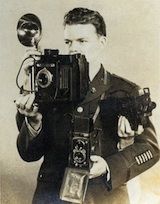- Forum
- General Discussion | Introductions | Off Topic Forum
- Photography General Discussion
- Photographing birds in flight
Photographing birds in flight
-
 Topic Author
Topic Author
- Lucky One
- Snapobsessed
-
- Nikon D300
- Followers: 57
- Posts: 315
-
Points:
160
Post #152529
1. Day time plenty of light
- how are you getting them near you, or are you just following them?
- what lens, camera settings are you using?
- is it ok to us bird feed to draw them in?
2. Getting darker and low light
- what lens are you using?
- are you using flash and if so have you had any luck with those flash extenders?
Any additional tips would be great. Thanks in advance for the help.
-

- effron
- Newbie
- Followers: 1623
-
Points:
129640
Post #152618
www.photomigrations.com/articles/0503100.htm
www.evergladesphotosociety.org/articles/flightpart01.html
www.vividlight.com/Articles/2303.htm
Why so serious?
-

- MLKstudios
- Banned
-
- D800 ;-)
- Followers: 72
- Posts: 4480
-
Points:
2
Post #152899
I got my first paid wedding coming up. What f/stop should I use, and should I shoot in Manual?
I want the pictures to come back perfect.
Matthew L Kees
MLK Studios Photography School
www.MLKstudios.com
[email protected]
"Every artist, was once an amateur"
-

- Baydream
- Moderator
-
- Canoni/60D/70D/5DmkIII
- Followers: 388
- Posts: 11185
-
Points:
7280
Post #152908
What the heck does this comment have to do with Birds in Flight?MLKstudios wrote: effie,
I got my first paid wedding coming up. What f/stop should I use, and should I shoot in Manual?
I want the pictures to come back perfect.
Shoot, learn and share. It will make you a better photographer.
fineartamerica.com/profiles/john-g-schickler.html?tab=artwork
-

- MLKstudios
- Banned
-
- D800 ;-)
- Followers: 72
- Posts: 4480
-
Points:
2
Post #152914
eta Bd, this is your area of expertise. Nothing else to add?
Matthew L Kees
MLK Studios Photography School
www.MLKstudios.com
[email protected]
"Every artist, was once an amateur"
-

- Scotty
- Agent 007
- James Bond, PT mod.
- Followers: 1088
- Posts: 9888
-
Points:
15096
Post #153044
MLKstudios wrote: It ends with a wink. Was commenting on effron's "tome" remark.
eta Bd, this is your area of expertise. Nothing else to add?
Stop derailing threads please.
When the last candle has been blown out
and the last glass of champagne has been drunk
All that you are left with are the memories and the images-David Cooke.
-

- Baydream
- Moderator
-
- Canoni/60D/70D/5DmkIII
- Followers: 388
- Posts: 11185
-
Points:
7280
Post #153138
I have been giving these a lot of thought because I don't want to give a "flip" or incorrect answer. Bird flight paths can be unpredictable so I generally back off the zoom a bit and give myself a little "breathing room: for crops (too many cut off body parts lying around).
I use the faster shutter speed available under the light conditions and change metering to match the shy conditions. Shooting a dark bird against a bright but overcast sky can be a killer (no fill flash here) so I tend to use spot metering. If the sky is nice and blue and the gift of clouds is offered, I will switch metering.
Patience and observing flight patterns is important to getting multiple shots. I have been studying a family of Bald Eagles for the past six years to try to determine any indicators as to when they will take off (love those shots and use burst mode). Depending on the time of day and the tide (and the particular bird), I can generally predict the direction they will take but not WHEN they will fly. I thought I had discovered a "body language" clue but it turns out that motion means a poop, not a take-off
Anyway, patience, a steady hand, decent zoom lens and practice will get your shots,
Shoot, learn and share. It will make you a better photographer.
fineartamerica.com/profiles/john-g-schickler.html?tab=artwork
-

- photobod
- Paparazzi
-
- Nikon D800 + D300
- Followers: 563
- Posts: 8907
-
Points:
150
Post #153159
www.dcimages.org.uk
"A good photograph is one that communicate a fact, touches the heart, leaves the viewer a changed person for having seen it. It is, in a word, effective." - Irving Penn
-

- MLKstudios
- Banned
-
- D800 ;-)
- Followers: 72
- Posts: 4480
-
Points:
2
Post #153166
Better answer!Baydream wrote: Thanks Scotty.
I have been giving these a lot of thought because I don't want to give a "flip" or incorrect answer. Bird flight paths can be unpredictable so I generally back off the zoom a bit and give myself a little "breathing room: for crops (too many cut off body parts lying around).
I use the faster shutter speed available under the light conditions and change metering to match the shy conditions. Shooting a dark bird against a bright but overcast sky can be a killer (no fill flash here) so I tend to use spot metering. If the sky is nice and blue and the gift of clouds is offered, I will switch metering.
Patience and observing flight patterns is important to getting multiple shots. I have been studying a family of Bald Eagles for the past six years to try to determine any indicators as to when they will take off (love those shots and use burst mode). Depending on the time of day and the tide (and the particular bird), I can generally predict the direction they will take but not WHEN they will fly. I thought I had discovered a "body language" clue but it turns out that motion means a poop, not a take-off
Anyway, patience, a steady hand, decent zoom lens and practice will get your shots,
Matthew L Kees
MLK Studios Photography School
www.MLKstudios.com
[email protected]
"Every artist, was once an amateur"
-

- Baydream
- Moderator
-
- Canoni/60D/70D/5DmkIII
- Followers: 388
- Posts: 11185
-
Points:
7280
Post #153190
Stop patronizing, Matthew. You had nothing to add. As I said, I THOUGHT about my response before firing off some flippant .,unrelated, or Googled-response.remark.MLKstudios wrote:
Better answer!Baydream wrote: Thanks Scotty.
I have been giving these a lot of thought because I don't want to give a "flip" or incorrect answer. Bird flight paths can be unpredictable so I generally back off the zoom a bit and give myself a little "breathing room: for crops (too many cut off body parts lying around).
I use the faster shutter speed available under the light conditions and change metering to match the shy conditions. Shooting a dark bird against a bright but overcast sky can be a killer (no fill flash here) so I tend to use spot metering. If the sky is nice and blue and the gift of clouds is offered, I will switch metering.
Patience and observing flight patterns is important to getting multiple shots. I have been studying a family of Bald Eagles for the past six years to try to determine any indicators as to when they will take off (love those shots and use burst mode). Depending on the time of day and the tide (and the particular bird), I can generally predict the direction they will take but not WHEN they will fly. I thought I had discovered a "body language" clue but it turns out that motion means a poop, not a take-off
Anyway, patience, a steady hand, decent zoom lens and practice will get your shots,
Shoot, learn and share. It will make you a better photographer.
fineartamerica.com/profiles/john-g-schickler.html?tab=artwork
-

- MLKstudios
- Banned
-
- D800 ;-)
- Followers: 72
- Posts: 4480
-
Points:
2
Post #153192
eta You should have used "telephoto" not "zoom". A zoom lens can be all wide angle.
I didn't get that from Google either.
Matthew L Kees
MLK Studios Photography School
www.MLKstudios.com
[email protected]
"Every artist, was once an amateur"
-

- Scott Grant
- Lone Wolf
-
- Nikon D7000
- Followers: 20
- Posts: 196
-
Points:
10
Post #153241
-

- MLKstudios
- Banned
-
- D800 ;-)
- Followers: 72
- Posts: 4480
-
Points:
2
Post #153245
If it's closer, you'll need to focus. Then you can use the camera's high-tech feature of track focus.
Follow focus was once a skill we had to learn. Before AF and new tech.
You might also want to look into Back Button Focus (most cameras have this option). It makes focus and shoot a two step process.
Matthew L Kees
MLK Studios Photography School
www.MLKstudios.com
[email protected]
"Every artist, was once an amateur"
Post #153297
Scotty and John, plenty of people get threads off topic, happens all the time on here; as moderators I think there needs to be some objectivity as you guys don't seem to getting on everybody about it when threads go OT. And a dry, sarcastic sense of humor tends to get lost or misinterpreted on message boards, I'm not sure it comes across as intended. You guys sometimes seem to not realize that something wasn't meant to be taken literally.
Sharon
- Forum
- General Discussion | Introductions | Off Topic Forum
- Photography General Discussion
- Photographing birds in flight
Latest Reviews
The Olympus Pen E-P7 is an affordable micro four thirds mirrorless camera with 4K video capabilities, a 20.3MP sensor, and 121 focus points, making it a solid entry-level camera for beginners.
The Panasonic G9 II is a 25.2-megapixel micro four thirds camera with numerous features that make it punch out of its weight class, like 779 AF points, 5.8K video, and weather sealing.
The Fujifilm XT5 is a 40MP mirrorless camera capable of 6.2K video at 30p. With those specs, it’s an ideal choice for photographers needing a camera to pull double duty for imaging and video.
The Canon EOS R100 is an entry-level mirrorless camera introduced in 2023. But just because it’s an entry-level camera doesn’t mean it’s a bare-bones camera. Find out why in this review!
Forum Top Posters
-
1Scotty 7 posts
-
2Roman Omell 4 posts
-
3Razky 4 posts
-
4Ruby Grace 3 posts
-
5Pat White 3 posts
-
6Nefarious 3 posts
-
7ShutterPal 3 posts
-
8Roger Lang 3 posts
-
9Jim Photo 3 posts
-
10CharleyL 3 posts
Latest Articles
In this guide to the bokeh effect, you’ll learn what bokeh is and the factors involved in creating it. You’ll also explore some beautiful example images to spark your creativity with bokeh!
Upgrade your kit in 2024 with the best intermediate camera on the market! The question is, what camera fits the bill? We’ve got three top options for you to choose from in this buyer’s guide.
The best photography jobs right now are a mix of tried-and-true gigs like wedding photography and new jobs highlighting AI’s capabilities, travel, and videography.
The Olympus Pen E-P7 is an affordable micro four thirds mirrorless camera with 4K video capabilities, a 20.3MP sensor, and 121 focus points, making it a solid entry-level camera for beginners.
Starting a photography business is one thing; sustaining your business over a long period of time is another. Use the tips in this professional photography guide to build something with longevity!
The Panasonic G9 II is a 25.2-megapixel micro four thirds camera with numerous features that make it punch out of its weight class, like 779 AF points, 5.8K video, and weather sealing.
Cinematic photography is an interesting genre that combines photographic and videographic skills along with effective storytelling techniques. The result? Highly impactful images!
Newborn photography requires skill, the right gear, and a lot of patience. This beginner’s guide discusses critical topics that will help you be more prepared for before, during, and after the shoot.















